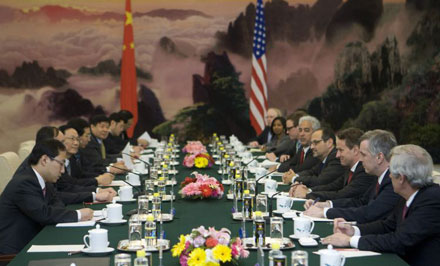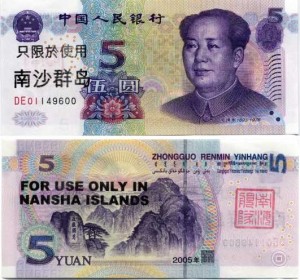
Geithner at U.S. – China Treasury Summit
Do you know what China’s currency, the Yuan (Renmenbi) looks like..?? If not, you’d better find out (see below); it’s going to matter a lot more in the years ahead as China flexes its global economic might. Further, sometime in the next few years there’s a pretty good chance you might need or want to have some in your savings and retirement account. But more about the Yuan later. Let’s put into context the economic self-interests of both nations to see why this trip was necessary.
U.S. Treasury Secretary, Timothy Geithner arrived in Beijing, China last Sunday touting what appeared as a relatively more pragmatic approach to America’s economic foreign policy engagement with China than had been the case by the tougher ‘Economic Hawks’ in the Obama administration such as Lawrence Summers, and including President Obama himself.
Geithner has used the trip to urge Chinese leaders to maintain their stimulus spending on big infrastructure projects, as well as to find new ways to entice their consumers into spending more of the nation’s high personal savings rate — Chinese consumers save on average almost 12% of discretionary family income; that equates to $1.7Tr (US) or about $1,200(US) per capita — to boost global demand. Asian countries led by China and Japan, are confronted with the reality that high savings and an over-dependence on exports to the US and the European Union, makes their economies very vulnerable.
Geithner will also seek to assuage China’s concerns about soft U.S. finances and regulatory reforms in a country that has become the single largest holder of U.S. government debt. However, Geithner is expected to refrain from making any provocative statements on the single thorniest economic issue between the two powers — namely, China’s notorious currency manipulation in order to generate high levels of foreign demand for Chinese products, and to maintain high levels of Chinese exports. How des China’s currency fit into all this..??
Yuan
The yuan – or renminbi – is the currency of China. As China rises to become one of the giants of the world economy – likely to overtake Japan to become number two in the next couple of years – it is inevitable that the Yuan currency, not the Euro, is going to challenge the greenback. It looks to me as though China is preparing the ground for the yuan to be used more freely, like the U.S. dollar, in the global economy.
Just before the London G20 Summit in April, Zhou Xiaochuan, the governor of the Chinese central bank of the People’s Bank of China, released a fascinating paper. In it, he suggested there was a need for the Special Drawing Right (SDR) to become the world’s key currency. In terms of its timing and the context the paper is possibly the most interesting monetary policy comment I’ve read anywhere in the world this year.
Governor Zhou Xiaochuan is a very worldly person. He knows that the SDR has been around since floating exchange rates came into existence and, despite repeated concerns about the dollar’s role since the world was forced off the fixed dollar exchange rate system in the late 1970s, the SDR is not really desired by anyone yet. In the past couple of years, as the world plunged into crisis, and even as we try to emerge from it, there are plenty of questions to be asked about the dollar, the yen, the euro, of course the much-maligned pound, and even the Swiss franc. Do investors want to hold the SDR (which is a basket of most of these currencies) instead? No, it appears they want to hold gold. Investors, including Mr Zhou’s colleagues at SAFE – the State Administration Foreign Exchange – who manage China’s foreign exchange reserves, have flocked to gold.
So what does Mr Zhou mean? Before I answer, consider this story from late last week. “Brazil to propose dropping dollar in China trade” ran the headline. It came from an interview in the Bejing-based Caijing Magazine in which Brazilian President Lula da Silva appears to have suggested that China should invoice Brazil for its trade with China in yuan, not dollars. Apart from the fact that Mr Lula has, in my judgment, been the most successful leader of this decade in terms of improving a major economy’s fortunes, latest Brazilian trade data shows China is now its number one export market. This also follows steps announced a few weeks ago for the yuan to begin being used for trade in Taiwan. Last year, Vladimir Putin called for greater use of the yuan.

Future Global Currency..??
Returning to the question posed above, I’ve concluded that Mr Zhou is telling us that China is closer than many think to letting the yuan become part of the SDR. To do that, he needs to allow greater commerciality of the Chinese currency, i.e. let people use it inside and outside China. He knows that, without that, it couldn’t become part of the SDR. I suggest he questions, just as I do, whether anyone will want to use it unless the SDR becomes something different.
Here’s another fact. Every five years the SDR is “updated” – its weights are changed to reflect economic reality. Currently the SDR consists of the dollar, yen, pound and euro. The next five-year re-weighting is due next year. It is probably a bit soon to include the yuan, but in another five years it is very likely. Is this what China really wants?
On one level, it is tough to see Chinese leaders allowing all of us to choose to buy and sell their currency when they won’t openly allow their own citizens to choose how many children they want. But think it through. We all learn from the past and the Chinese leadership strikes me as understanding plenty about the challenges the world faces.
Fixing the yuan so closely to the dollar has greatly contributed to China building its foreign currency reserves to two trillion dollars. Do they want that pile to rise to four trillion? Almost definitely not, as they now realise how tough it is to have the value of their foreign currency investments staying so high in yuan terms. In any case, luckily, because of the crisis and the related adjustment to US consumption, Chinese surpluses that generated the reserves are on their way down. Indeed, as each week passes, there is more evidence that this crisis is good for China, and certainly China’s role in the world economy. Since last October, China has announced massive fiscal and monetary stimulus and started on the path to social security reform. It has already announced its intention to introduce basic medical insurance by 2011.
On the back of those initiatives, and especially the boom in financial conditions, four weeks ago Goldman Sachs raised their Chinese GDP forecasts, forecasting a +8.3% for this year, and +10.9% for next. Not bad for a global financial crisis, huh..?? It is sound as though Chinese policy-makers are getting more confident and are thinking about life without the need for the dollar. Welcome to the core part of my evolving thesis on the next phase — post-Laissez faire — of the global economy.
This article is based on Goldman Sachs Global Economic Research by Jim O’Neill.